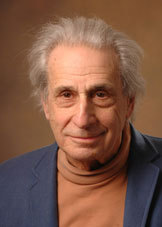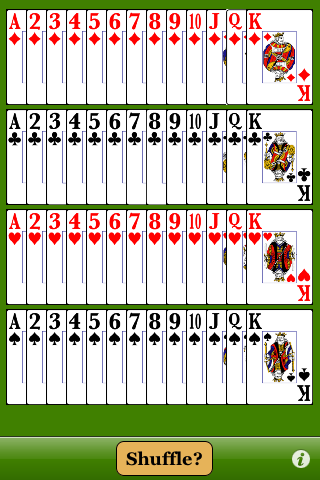Products
Five Squares Into Four Challenge
The Challenge
The challenge is to move two sides (simulated matchsticks) and change the configuration of five squares into a configuration of four squares. The sides may not be removed. They all remain in play. They all stay the original size. There are no tricks to the solution like laying one side on top of another.
The mechanics of making moves are to select a side to move by tapping on it and then selecting an unoccupied place on the grid to move it to. When a side and an unoccupied place are both selected, the side will move. Dragging does not work. The player may also select the unoccupied place first and then select the side to move. When a side is selected, by tapping on it, it will change color and there will be a "tock" sound. If an unoccupied place is selected first it will turn blue and there will be a "tick" sound. If you change your mind before selecting both a side and an unoccupied grid place, just select something else and the selection will change.
A Hint
How many sides (matchsticks) are there? 16? Right! Are 16 enough to make four squares? In the starting configuration there 16 sides that make five squares. To form more than four squares some sides must be shared by adjacent squares and those sides are the sides of more than one square.
Background
I became acquainted with the Five Squares Into Four puzzle in the early 1980's but I suspect that it is much older. It was a popular bar bet and usually done with real matchsticks, the old wooden ones. A rumor at the time was that the puzzle was presented to a graduating class at West Point of several hundred cadets in an auditorium with viewgraph projector technology. All graduating cadets receive a Bachelor of Science degree. At the end of 20 minutes about half of the class had solved the puzzle of Five Squares Into Four. At the end of an hour, 15 cadets were still struggling. Apparently, there was no relationship between class standings and success at solving the puzzle. What I have found interesting in my own experience is that a few women have solved immediately, in about 20 seconds or less. I do not recall a man solving in less than five minutes.
While the challenge is to change the configuration from five squares to four squares by moving only two sides, this provision is not strictly enforced. A player can make as many moves as they wish. After each move the program checks for a solution and responds appropriately. After getting a solution, a player can continue to move the sides around and whenever the configuration has exactly four squares, it will be reported. Alternately, after solving, or at any time, a player can hit the reset button in the lower right of the grid and the configuration will be reset to the starting configuration and the timer reset.
If you give up, you can select the "play" button in the lower right corner of the main view and you will be shown the solution. After the solution configuration is displayed about 10 seconds, it will change to the starting pattern.
The Solution Configuration Looks Like This:
The solution configuration blinks on and off for about four seconds.
Last Card Wizard
The Last Card Wizard is a card trick where the player secretly picks a number between one and ten, uses it to select a starting card, and then "chains" through the deck, from link to link to a final link. The player continues tapping cards through the actual last card so as to not give away the last link card. (Of course, occasionally the actual last card might be the last link but this is unusual.) When all of the cards are turned up and the actual last card is tapped, the wizard program highlights the last link card in yellow.
Chaining through the deck is done like this. The player begins by tapping the first card and each consecutive card through the last 52nd card of the deck. But while tapping the player first counts to their secret number and silently note the card at that location. That card is the first link card. It's value determines the number of cards to count to get to the next link card. The counting begins with the card to the immediate right of the link card.
The value of the card is it normal value except that an ace must be counted as one and the picture cards, Jack, Queen, and King, must be counted as five.
The value of the card is it normal value except that an ace must be counted as one and the picture cards, Jack, Queen, and King, must be counted as five.
The prediction method was developed by Martin D. Kruskal , a mathematician and physicist who lived from 1925 to 2006. In Kruskal's prediction of the last link card is usually correct but not always. The Last Card Wizard's prediction of the last link card will always be correct without exception.
Many explanations of how the Kruskal mode works are available on the web, including YouTube demos with real playing cards. Just search on "The Kruskal Count". There is a particularly good write-up by Ivars Peterson at www.maa.org/mathland/mathtrek_12_24_01.html. There is a formal mathematically paper on the subject at www.arxiv.org/abs/math/0110143.
Martin D. Kruskal, 1925 - 2006The Kruskal Count and the Last Card card trick were popularized by Martin Gardner in his Scientific American column, Mathematical Recreations.
Martin Gardner, 1914 - 2010
Uri Geller performed the Last Card trick with real cards on the Johnny Carson Tonight Show sometime around 1975. He failed to get the last card correctly. Merv Griffin declared that the failure proved to him that Geller's powers were genuine. Magician's tricks, Griffin explained always work. We all know how the "force" comes and goes.
Johnny Carson, 1925 - 2005,
Carnac , the Magnificent
Carnac , the Magnificent
The following are screen-shots from the Last Card Wizard app.
Initially the cards appear face-down in four rows of 13 cards each. Then they are flipped over, revealing that all of the cards are there, and in order.
The app waits for the play to click on "Shuffle?". The cards are shuffled by starting at the beginning of the first row and card-by-card making an exchange with a randomly selected other card.
When all of the cards have been shuffled, a pale blue film is put on them and the player can do their count through the deal. Each card must be counted. When a card is count the blue film is removed, card-by-card. This is to help the counter keep track of where they are.
If the player looses count they can click on the "Recount?" button and start over. When the player clicks on all of the cards, the Last Card Wizard announces the players last card in the chain of links based on their original secret number between 1 and 10.
The Last Card is highlighted in yellow and the center button label says "Solved!". If the play thinks the Wizard got it wrong, they are advised to select Recount?. After a few seconds the "Solved!" is replaced by "Shuffle?" and the player can have another go at it with a new shuffle.
Filipiak Number Exchange
The objective of the Filipiak Number Exchange puzzle is to put the numbers in order, by exchanging one number with another in the fewest number of exchanges. The two numbers to exchange are selected by touching one and then the other. When a number is in its correct location it is displayed in blue instead of black. Initially, all of the numbers are in order, six rows of four numbers each, from 1 through 24. to start you tap Play and the number are randomly shuffled. One or a few may be in their correct locations. That is a bonus for the player.
And after the shuffle...
The numbers 1 through 10 are in their correct positions. After 12 more exchanges the puzzle has been solved.
The Filipiak Number Exchange puzzle is from the book "Mathematical Puzzles And Other Brain Twisters" by Anthony S. Filipiak. It was first published in 1942.
















